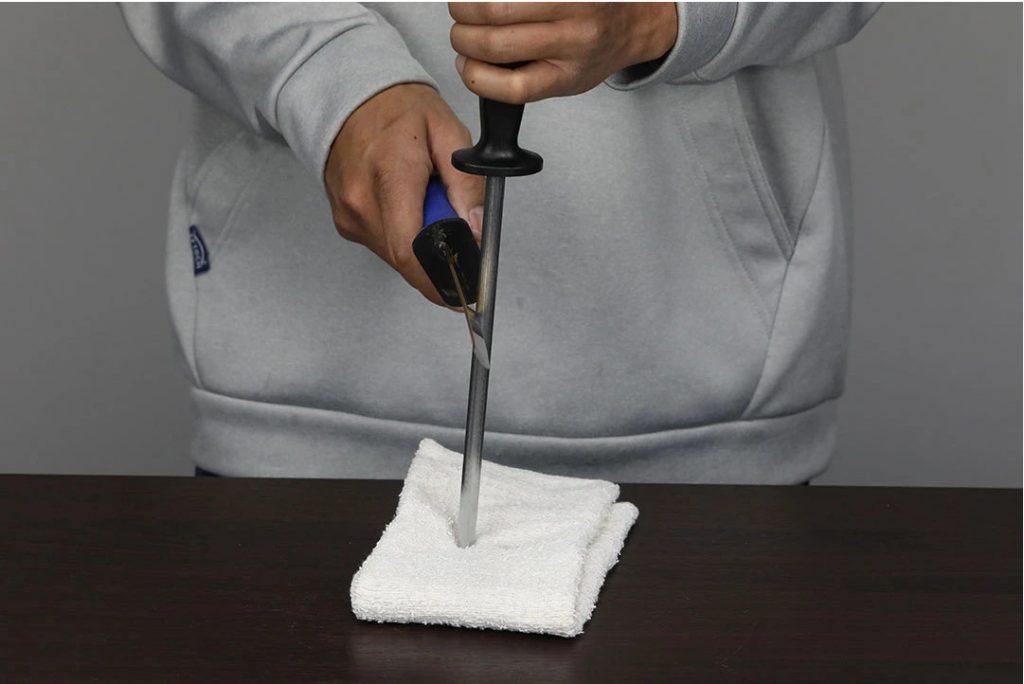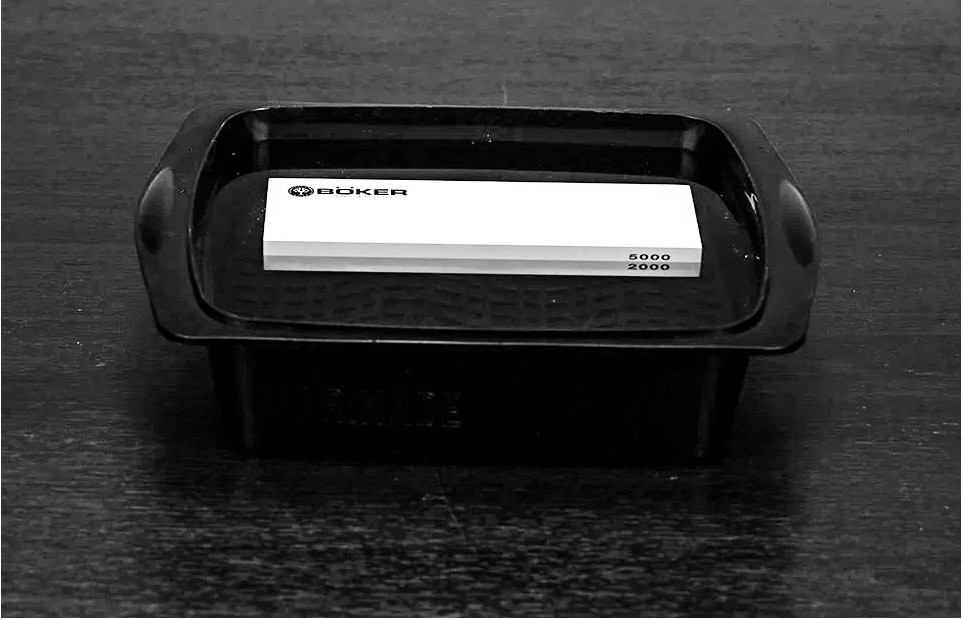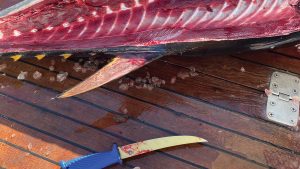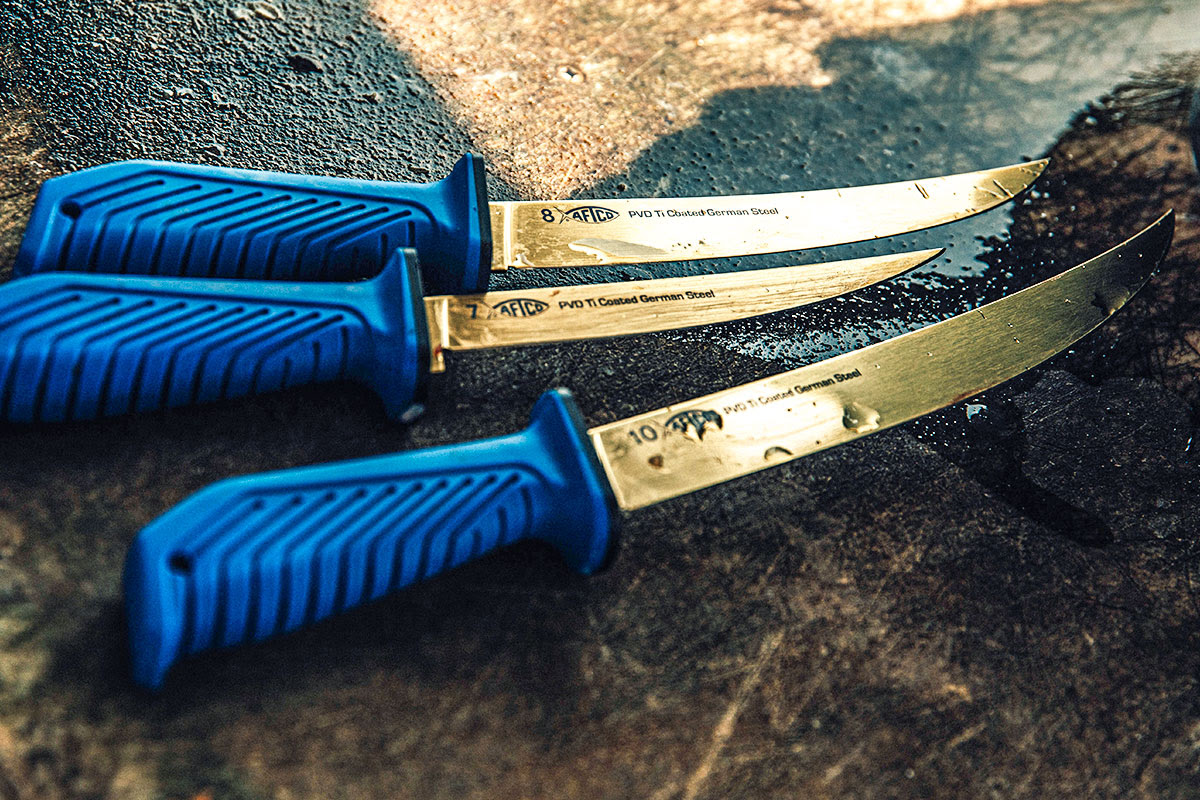AFTCO Fillet Knives have quickly become a staple in the tackle bags of all anglers. Whether on your camping trip filleting walleye or perch, or offshore breaking down a large tuna or swordfish, the AFTCO line of fillet knives are perfect for the job. Now available in five models: the standard 8”, 10”, and 12” lengths, and a flex series in 7” and 9”. But, when you have this knife at home, how do you ensure your knife stays sharp enough to properly break down your catch?
Do I Need To Sharpen My AFTCO Fillet Knife?
AFTCO Fillet knives are made with Boker 4116 Stainless steel featuring a 56-58 on the Rockwell Hardness scale. This makes our filet knife a soft steel knife. Soft steel knives are the result of German Stainless steel and are perfect for flexible knives cutting through small bones like an AFTCO filet knife. The reason you want a soft knife is to reduce micro chips in the knife when hitting rib bones or backbones in a fish. The soft steel’s edge, rolls, saving the knife from breaking. Because the edge rolls, it requires consistent honing. Honing a blade takes that rolled edge and brings it back to a straight edge, making it sharp again. When honing a knife, you are not sharpening the knife but rather reshaping the edge. We recommend honing a blade at least every day you use the knife but to ensure the sharpness, it is best to hone your AFTCO filet knife before every single large fish. If your knife does not get honed often, then the blade will continue to roll more and more making your knife feel dull. Once it is rolled too far, no amount of honing will reshape the edge, and you will have to sharpen the blade creating a new edge. Aside from honing though, we do recommend sharpening your AFTCO knife at least once a year, or more, if you use it very frequently.
How To Hone a Knife
There are many techniques to hone a knife and a method we found useful is placing the tip of a honing steel on a towel to prevent slipping. Place your knife at a very slight angle to the honing steel and in a downward motion with light pressure, swipe down running the whole blade along the steel, making sure to not forget the tip. Do this on each side equally, approximately 8-10 times. You will become faster and find the way you prefer to hone your steel with experience. Again, this should be done before using the knife each day.

How To Sharpen a Fillet Knife
Once a year or sometimes more depending on use, your knife will need a true sharpening. This requires a sharpening stone of some sort. There are water stones, known as whetstones and oil stones and we like to sharpen our AFTCO knives with whetstones. The first step is to choose the stone you are going to be using. When knives get very dull and have microchips, they require a coarser grit stone to start with to create a new edge. Think about sandpaper, and the same method applies. We start with a coarse grit such as 300 or 400 to create a new edge. After that, a 3000 to 8000 grit is considered fine grit and will be used for polishing the blade, and honing. If you want to use only one stone, a 1000 medium grit stone is recommended.
How To Use a Sharpening Stone
Once you have your whetstone, the stone may need to be soaked in water for at least 20 minutes (preferably 30 minutes). If you bought a “splash and go” stone, then you can skip that step. Once you have soaked or prepped the stone, its time to get started.

The one thing you need to make sure you get right when sharpening knives is keeping a consistent angle on the knife blade as you sharpen. A tip to know, a good angle is to place two quarters on your sharpener and lay the top of the knife on the edge of the quarters and keep that angle once you remove the quarters and start.
A good way to think about it, is to sharpen your knife in the direction you normally use your knife. Since we slice by pulling with a fillet knife, use that motion. When sharpening knives that you chop with and push down, sharpen in a pushing motion similar to a downward chop.
Start with a coarse or medium grit stone, and hold the knife in your dominant hand. If you are sharpening the 8, 10 or 12 inch fillet knife, place three to four fingers of your secondary hand on the blade to use for pressure. If you are sharpening the flex 7 or 9 inch blade, use two fingers since the blade is thinner, hiding any other fingers so they are not open to an accident. Using a slicing motion, run the blade from heel to toe making sure you sharpen the whole blade, counting the amount of times you make the slicing motions.
After making a few sharpening motions on the stone on one side, flip to the other side of the blade and try to keep the angle you initially used and repeat the amount of swipes you had made previously.
Once you have done the first set of sharpening, you can carefully rub your finger against the edge to feel for a burr. The burr tells you that you have created a new edge and you are ready to move on to the next stone. If you do not feel the burr, that is okay. Continue doing the previous motions in increments of 10 sweeps until you feel a noticeable burr.
Whether you go from coarse to medium or medium to fine, complete the same exact motions for another 30 to 40 strokes each side. Now that you are on the fine grain, you are going to polish the stone. Since the grain is so fine, it polishes the blade when you strap the blade. Think about old time westerns where the cowboys used their leather belts to strap their knives. Same thing! But with a polishing stone.
With your fine grain stone, you can do the same motion as before making sure you get contact on the whole knife. Only do it in one direction, starting with 10 times on each side, and then 8 strokes each side, then 6, 4, 2, and then do one stroke on both sides multiple times. Along with polishing the knife blade now you are taking off the burr to leave only a precision sharp knife once you are done.
After sharpening make sure to hit your knife on your honing steel just a few more times to dial in your edge. Now it’s time to test on a tomato or a piece of paper ensuring you got the edge you’re happy with.
This process may take time and may take practice but doing this once a year with your knives will ensure you have sharp knives to break down fish of all sizes. Dull knives cause more accidents in kitchens and on boats more than anything else, so please be sure to keep your AFTCO knife sharp and it will last you a lifetime.




